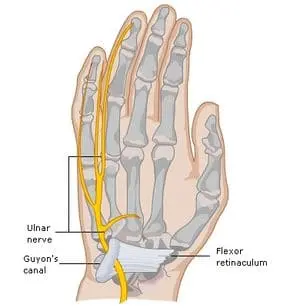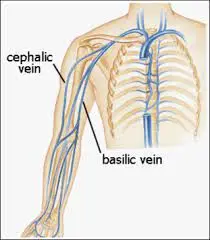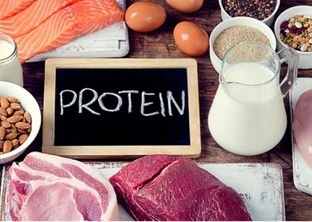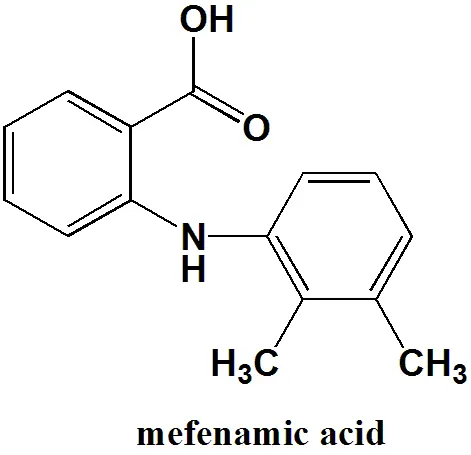Guyon Canal
The Guyon Canal, also known as the ulnar canal or Canal of Guyon, is a narrow passageway located in the wrist, specifically at the ulnar side.
Named after French surgeon Jean Casimir Félix Guyon, who extensively studied the anatomy of the hand, this canal serves as a conduit for the ulnar nerve and artery as they traverse from the forearm to the hand.
The Guyon Canal is a crucial anatomical structure, playing a significant role in the innervation and vascular supply of the hand.
Introduction
The most common ulnar nerve problem is guyon canal. When something presses on the ulnar nerve in your elbow or wrist, it can cause a guyon canal syndrome. Nerve damage and neuropathic pain can result from inflammation caused by compression, particularly a pinched nerve. This can sometimes weaken your grip, making it difficult to hold objects.
The ulnar artery, venous and lymphatic arteries, and the ulnar nerve and its branches are all located within the Guyon canal. The superficial (sensory) branch and the deep (motor) branch of the ulnar nerve originate from Guyon’s canal respectively. Other names for it include the ulnar tunnel or the ulnar canal. An anatomical fibro-osseous structure makes up this canal. The canal terminates distally at the hook of the hamate and starts at the proximal edge of the pisiform bone. The ulnar nerve and ulnar artery go through this anatomical region before entering the hand from the distal forearm. The cubital tunnel is the fourth most frequent location where the ulnar nerve is compressed, followed by the Guyon canal.
Guyon canal syndrome can be treated with wrist immobilization, painkillers, physical therapy, or, in extreme situations, surgery.
Anatomy Significance:
The ulnar nerve arises from the brachial plexus’s medial cord (C8-T1), passes through the axilla and the anterior compartment of the arm then enters the intramuscular septum and moves through the posterior compartment. After that, it passes posteriorly through the cubital fossa and the medial epicondyle. After that, the nerve travels between the flexor digitorum profundus and flexor carpi ulnaris muscles. Before entering Guyon’s canal, the ulnar nerve branches off dorsally proximal to the pisiform bone.
The Guyon Canal runs from the hook of the hamate distally to the proximal border of the pisiform bone. As they move through from the distal forearm to the hand, the ulnar nerve and ulnar artery pass through the Guyon canal.
Borders:
The ulnar canal is around 4 centimeters long. It reaches the origin of the hypothenar muscles at the hook of the hamate and the proximal side of the pisiform bone.
Among its borders are;
- Medial (ulnar): abductor digiti minimi muscle, flexor carpi ulnaris tendon, and pisiform.
- The lateral (radial) hook of Hamate.
- Roof: carpal ligament of the palm.
- Floor: hypothenar muscles, pisohamate ligament, and flexor retinaculum.
The content:
The ulnar neurovascular loop enters the hand through the ulnar canal:
- The ulnar nerve splits into deep (motor) and superficial (sensory) branches inside the canal.
- The ulnar artery is located on the radial aspect of the ulnar nerve. The superficial palmar arch, which is visible lateral across the palm, originates from it.
- Vascular lymphatics
Structure and Function:
The guyon canal covers the ulnar nerve and ulnar artery as they travel through the distal wrist and into the hand.
This framework is made up of the following structures:
- Alternatively referred to as the palmar carpal ligament, the volar carpal ligament forms the volar part or roof of the canal.
- The dorsal part, or floor, of the canal, is formed by the transverse carpal ligament.
- The abductor digit minimi, pisiform, and pisohamate ligament create the ulnar boundary of the canal.
- The hook of the hamate and the transverse carpal ligament form the radial boundary.
Lymphatic System and Blood Supply:
Shortly after the brachial artery travels medially toward the hand, the ulnar artery splits off from it. It is situated directly lateral to the ulnar nerve in the distal forearm. When the ulnar artery that is close to the Guyon Canal produces volar and dorsal carpal branches that supply the carpal bones.
It contributes to the superficial and deep palmar arterial arches after passing via the Guyon Canal. Because the radial palmar arches eventually connect with the superficial and deep palmar arches and their respective branches, attention must be taken when performing hand surgery due to these anatomical variances. Usually, venous and lymphatic vessels pass next to artery vessels.
Nerve:
The Guyon canal is directly crossed by the ulnar nerve. The ulnar nerve splits into the superficial branch and the deep branch as it travels through the canal. Nerves that supply feeling to the hypothenar area and to half of the fourth and all of the fifth digits are found in the superficial branch.
This nerve continues far, exiting the little finger through the ulnar digital nerve and the common digital nerve of the fourth web. It is a motor branch, the deep branch.
Muscles:
After passing through the Guyon Canal, the ulnar nerve’s deep branch becomes exclusively motor. It innervates the two medial lumbrical, the medial head of the flexor pollicis brevis, the adductor pollicis, the opponens digiti minimi, the flexor digiti minimi, and the abductor digiti minimi. The hypothenar muscles may occasionally get innervation from the superficial branch.
Pathophysiology:
The 4-centimeter-long Guyon Canal is surrounded by four borders. The volar carpal ligament makes up the roof. The transverse carpal ligament serves as the flooring. The hamate hook is located on the radial border, while the pisiform bone and pisohamate ligament make up the medial border. The ulnar nerve and artery are located inside this canal. The ulnar nerve is a mixed sensory-motor nerve when it enters the canal. The nerve divides into deep motor branches and superficial sensory branches as it passes through it.
Every ulnar nerve segment impacted in the Guyon canal area is represented by a specific zone and presents with a distinct set of symptoms.
Zone 1: proximal to the motor/sensory bifurcation
- Just before the ulnar nerve splits into the deep motor and superficial sensory divisions, there is a distal portion of the main trunk.
- The hook of hamate fracture, malunion, nonunion, and ganglion cysts are among the etiologies.
- Mixed motor and sensory symptoms arise from ulnar nerve damage in Zone 1 Guyon canal injury.
Zone 2 (the most frequently impacted): radially to zone 3 and distal to the motor/sensory bifurcation
- Relates to the deep terminal motor branch of the ulnar nerve; when affected, only motor symptoms (weakness, for example) will manifest.
- Among the causes are non-unions, malunions, hook of Hamate fractures, and ganglion cysts.
- All of the interosseous muscles, the fourth and fifth lumbricals, the adductor pollicis muscle, and the hypothenar muscles (opponens digiti minimi, abductor digiti minimi, and flexor digiti minimi brevis) are innervated by this deep branch of the ulnar nerve.
Zone 3: Distal to the motor/sensory split and ulnar to zone 2
- In this area, the ulnar nerve’s superficial sensory terminal branch is damaged, resulting in purely sensory symptoms like tingling and numbness, as well as a burning sensation.
- Etiologies include thrombosis and/or ulnar artery and artery rupture.
Physiological variations:
Every patient has ulnar nerve compression in the Guyon Canal with a different phenotypic manifestation. This results from differences in the ulnar nerve’s anatomy as it travels through the tunnel. It splits into branches that are shallow and deep. In 80% of instances, this is accurate.
The nerve splits while going through the Guyon Canal in about 10% of instances. Two sensory nerves the ulnar digital nerve of the little finger and the common digital nerve of the fourth web and one motor nerve the deep branch are produced by the trifurcation. Rare anatomical variants with unusual branching patterns make up the remaining 10% of instances.
These odd variations include, for example;
- Ulnar nerve branching abnormally in the distal forearm.
- All three branches of the low trifurcation pass through the Guyon Canal, which is located close by.
- High trifurcation at Guyon Canal, The volar sensory branch can pass volar to the canal, or all three branches can travel through Guyon’s canal.
- These branches are also known as accessory branches of Kaplan. They originate from the dorsal sensory branch of the ulnar nerve.
- Branches that connect in the forearm of the ulnar and median nerves.
- Upon examination, numerous unusual muscular structures were found. These muscles were classified as abnormal abductor digiti minimi muscles for the most part.
Why does it happen?
There are several possible reasons why there could be compression;
- Ganglion
- Repetitive trauma
- Unstable wrist on the ulnar side
- Synovitis
- Tumors
- Hamate fracture hook or nonunion
- Anatomical alterations in the ulnar tunnel caused by carpel tunnel syndrome may result in functional impairments.
Symptoms:
Your hand, wrist, and little finger are all impacted by a compressed ulnar nerve.
The signs and symptoms consist of;
- Having pain while grabbing anything
- It can be intermittent or continuous, but numbness or tingling in the ring and little fingers.
- Incapacity to grasp objects or use fine motor skills due to weakness in the hand and wrist.
- Hand and wrist pain can be either dull or intense, and that gets worse as you exercise.
- loss of hand and finger dexterity and coordination might make it challenging to do writing and typing chores.
- Discomfort and swelling in the wrist, sometimes with a burning feeling.
- In more advanced forms of Guyon canal syndrome, the hand and wrist muscles may be atrophy.
What sensation is associated with Guyon’s canal syndrome?
The middle and little fingers typically experience a pins-and-needles sensation at first, which is frequently felt in the early morning when first waking up. This could worsen into a searing ache in the hand and wrist, then cause tingling in the little and ring fingers. Weakness in the ulnar nerve-controlled muscles can cause clumsiness in the hand.
The muscles that pull the thumb into the palm and the tiny muscles in the hand’s palm can both be affected by weakness. It becomes difficult to expand your fingers and pinch with your thumb as these muscles gradually weaken.
While carpal tunnel syndrome (CTS) is significantly more common than this syndrome, the two disorders can coexist. These two syndromes produce numbness in separate parts of the hand. Pain and numbness expand to the thumb, index finger, middle finger, and part of the ring finger in (CTS) patients when the median is squeezed.
In Guyon’s canal syndrome, compression of the ulnar nerve typically results in numbness in the pinky and half of the ring finger.
Physical Evaluation:
Examining the hand for clawing, atrophy of the hypothenar or interossei, incapacity to cross fingers, or any masses over the wrist is the first step in a physical examination. The presence of tenderness over the hamlet hook could indicate a fracture.
- Tapping over the suspected nerve compression site would replicate the symptoms of Tinel’s sign.
- When the patient is asked to hold a piece of paper between his thumb and fingers while the examiner tries to pull it, a weakness in the adductor polices muscle, which is supplied by the ulnar nerve, is observed. This results in a compensatory movement of the thumb that is thumb flexion rather than thumb adduction. This signifies the Froment’s sign.
- Wartenber’s sign is the little finger placed in an over-abducted position while at rest.
- When ulnar artery thrombosis is suspected, Allen’s test can be used to examine the hand’s arterial blood supply.
Diagnosis:
Guyon’s Canal Syndrome patients feel numbness in their little fingers and partially in their ring fingers. Spreading and pinching the thumb becomes difficult when the ulnar nerve-controlled muscles gradually weaken.
A physical examination and maybe a nerve conduction velocity (NCV) test are necessary to identify the type of compression and its exact location. The NCV test measures speed An electromyogram (EMG) may occasionally be included in this evaluation.
if the ulnar nerve-controlled forearm muscles are working sufficiently, this can be ascertained by the EMG. You might also get an X-ray to look for a fracture or dislocation if the symptoms were caused by a traumatic wrist injury.
In addition to taking your medical history and examining you physically, your doctor will evaluate your symptoms. It is possible to order imaging tests like CT, MRI, or X-rays. You may be provided with particular tests, such as Doppler ultrasonography, to evaluate the flow of the ulnar artery.
Conduction velocity tests, which measure the speed at which electrical signals pass through nerves, are used to confirm the diagnosis.
Treatment:
The length and intensity of the symptoms, as well as the exact cause that has been identified as the source of the symptoms, will determine whether conservative or surgical management is preferable.
The physician initially suggests non-surgical methods to address Guyon’s canal syndrome, such as;
- At-home cures
- Using instruments with safeguards
- Applying cooling pads
- Remain clear of activities that exacerbate pain
- Immobilization with a splint or brace prescription drugs for discomfort
- Massage treatment
- Injections of steroids
If conservative measures are insufficient in relieving the ulnar nerve’s pressure, surgery is advised.
Operative:
- Surgically decompressing the ulnar nerve by excising any Guyon’s canal formations that might be problematic
- Guyon’s canal may be indirectly decompressed via carpal tunnel release.
- Tendon transfers may be taken into consideration in late cases to treat abducted small fingers, pinch fingers, or rectify fingers that are clawing.
Management of Physical Therapy:
Conservative care involves bracing and patient education. Nerve glide exercise may be added, depending on the patient’s situation and preferences.
The patient is advised to refrain from repetitive stress-inducing activities like weight bearing, cycling, and handlebar modifications on bicycles. Additionally, stay away from repetitive motions or static postures that put the body under mechanical stress, like extended wrist extension.
A resting hand splint is recommended for the patient in order to neutralize their wrist. For a duration of one to twelve weeks, the splint should be maintained at night and during unpleasant activities.
What can I expect from the canal release process Guyon?
Under general or regional anesthesia, the procedure is carried out as a day case. After the treatment, the fingers and thumb remain free, but a thick dressing is placed across the wrist and palm. Occasionally, a volar slab is used to provide wrist support for four to five days.
After two weeks, the sutures are taken out and the dressing is lowered within a week. While the healing process may take longer, the initial days or weeks usually show an improvement in the sensory problems. If there was pre-existing muscle weakness or wasting, it would be better to intervene before the muscles are already wasted, as recuperation could take many months.
Lowering of hazards and prevention:
There are no particular safeguards against Guyon canal syndrome that can be applied to every situation. But, by taking some safety measures, you might be able to lower your risk.
Follow these recommendations;
- To give your hands and wrists a break at work, take breaks.
- To finish tasks, use a lighter grip and less force.
- Steer clear of tasks or duties that seem repetitive.
- Choose padded and ergonomic devices.
- Try to keep your wrists and hands warm.
- When working, avoid resting your elbows on furniture or armrests.
- To avoid hamate fractures, practice good technique when hitting, golfing, or playing tennis.
Individuals at Risk:
Numerous activities that put constant pressure on the palm, like cycling and weightlifting, as well as unusual activities that put a lot of strain on the wrist, like using a jackhammer or crutches, are among the known causes of this condition.
An ulnar nerve compressed within the canal may result from a catastrophic wrist injury. Furthermore, there is a chance that arthritis could worsen and compress the nerve in the wrist bones and joints.
The following factors increase your risk of Guyon canal syndrome;
- Using vibrating implements
- Experience trauma to the hands
- Perform hand-intensive tasks repeatedly
- lift weights.
- Cycling on long distances
- Sports like badminton, golf, tennis, and baseball batting can cause a hand fracture in the hamate bone.
Summary:
The wrist is where Guyon’s canal syndrome manifests. The Ulnar nerve can become trapped in Guyon’s canal (ulnar canal) at the wrist due to various factors, including repeated compression, extended wrist flexion, trauma, edema, fractures, and vascular diseases. This is commonly brought on by direct pressure on a bike or cycle handlebar, weightlifting, excessive gripping, twisting, or repetitive wrist and hand movement. Guyon’s canal syndrome can affect professional cyclists, cricketers, golfers, weightlifters, and high-performance athletes.
Guyon’s canal is a fibro-osseous tunnel located in the anterior part of the wrist. It is also referred to as the ulnar tunnel or canal. It is marginally proximal to the flexor retinaculum and superficial. The distance between the pisiform’s proximal side to the hamate hook is around 4. Guyon’s Canal Syndrome is a frequent nerve compression that affects the ulnar nerve as it passes through the wrist tunnel known as Guyon’s Canal. The discomfort, tingling, weakness, or numbness may result from this compression of the nerve.
Most of the time, this illness is curable either with the right care or on its own. Surgery may be required on occasion, particularly if there has been nerve damage or muscle atrophy. Treatment consists of a conservative management regimen. while utilizing surgical compression for a compressive lesion (such as a ganglion) or when symptoms are ongoing.
FAQ:
Guyon’s canal is a fibro-osseous anatomical canal on the medial side of the hand. It is also referred to as the ulnar tunnel or ulnar canal. It extends between the proximal margin of the pisiform bone and distally at the hamate hook.
As they move from the distal forearm to the hand, the ulnar nerve and ulnar artery pass through the Guyon canal.
The artery in the ulna
Following its route through the Guyon canal and the ulnar nerve, the ulnar artery splits into superficial and deep branches, creating the superficial and deep palmar arches, respectively.
Guyon’s canal syndrome, also called the ulnar tunnel, is a group of symptoms and indicators caused by compression of the ulnar nerve in Guyon’s canal. It is known as handlebar palsy in cyclists who experience it as a result of repetitive trauma.
Guyon’s canal syndrome is caused by an obstruction of the ulnar nerve as it passes through the wrist tunnel known as Guyon’s canal. This issue is comparable to carpal tunnel syndrome, but it affects a different nerve entirely. In some cases, the two circumstances may contribute to a hand issue.
Sharp pain going up the arm from the hand or wrist.
The ring and pinky fingers are numb.
The thumb and palm are weak.
Difficult to hold on to.
Incapable of joining the thumb and index finger in a pinch.
The ulnar artery and nerve travel via Guyon’s canal, a tunnel, as they cross the wrist. The ligament that joins the two bones the hamate and pisiform forms this tunnel.
Zone 1 is the region immediately in front of the bifurcation of the ulnar nerve into the motor and sensory branches.
Zone 2 The deep motor branch of the ulnar nerve is included.
Zone 3 Symbolizes the region covered by the superficial sensory branch.
The ulnar nerve and ulnar artery are secured by the guyon canal as they pass through the distal wrist and into the hand. It is composed of the following structures. The volar section, or roof, of the canal is formed by the volar carpal ligament, also known as the palmar carpal ligament.
Activities like weight bearing, cycling, and handlebar modifications that result in repetitive stress at Guyon’s canal are advised to be avoided by the patient. Steer clear of static poses or repetitive actions that place your body in a state of mechanical overload, such as holding your wrist extended for a long time.
Ganglion cyst.
fractured wrist.
Trauma or persistent pressure on the hands and wrists.
Engaging in specific sports, like cycling and weightlifting.
Construction and other jobs involving vibrating tools.
Tinting in the small and ring fingers can be evolved by applying pressure to the ulnar nerve at Guyon’s canal. Electrophysiological tests assess the nerve’s capacity to transmit electrical signals and the muscles’ capacity to react to these signals.
Even though every patient heals differently, you should anticipate needing to attend our physical therapy or occupational therapy sessions for six to eight weeks in order to fully recover. This could take several months.
Steer clear of heavy grasping, placing your palm against hard surfaces, bending your wrist outward when working, and repeating hand motions. In order to lessen the symptoms of Guyon’s canal syndrome in its early stages, you might be required to wear a wrist brace.
Guyon Canal Syndrome is by far the most prevalent cause of wrist compression syndromes, after carpal tunnel syndrome. Different sensory and motor symptoms are caused by ulnar nerve compression at the Guyon’s canal, depending on where the compression occurs.
Ulnar neuropathy at the wrist where it flows through the Guyon canal is called ulnar tunnel syndrome, as well as Guyon’s canal syndrome and handlebar palsy. A deep motor branch palsy of the ulnar nerve resulting in weakness of the interosseous muscles is the most typical presentation.
The distal part of the ulnar nerve is injured as it passes through a small anatomical passage at the wrist in Guyon Canal Syndrome, a relatively rare peripheral ulnar neuropathy.
The hand’s hypothenar region may have previously experienced repetitive trauma or stress. Guyon’s canal syndrome is a condition that long-distance cyclists may get due to pressure from the handlebar bar on the wrist. Depending on where the compression occurred, the symptoms may be solely motor, purely sensory, or both.
Injections of steroids are a useful therapy for alleviating Guyon’s canal syndrome symptoms. In order to relieve pressure and reduce swelling, steroids are injected directly into the ulnar nerve. By reducing inflammation, the injections relieve pressure on the nerve.
Through the use of magnetic resonance imaging to observe anatomic differences inside the Guyon canal, it is possible to determine whether any structures such as lipomas, ganglion cysts, or aberrant muscles are the cause of the compression by force of the ulnar nerve. Ulnar artery thrombosis is diagnosed by Doppler ultrasonography.
References:
- Canal Guyon (n.d.). Guyon Canal Physiopedia https://www.physio-pedia.com Reference within the text: Guyon Canal, n.d.
- Guyon’s – Borders – Contents – Compression – TeachMeAnatomy – The Ulnar Canal (2022, January 16). https://teachmeanatomy.info/upper-limb/areas/ulnar-canal/ is the URL for TeachMeAnatomy. The Ulnar Canal – Guyon’s – Borders – Contents – Compression – TeachMeAnatomy, 202 is the in-text citation.
- J. L. Ramage (2023, August 14). anatomy, Guyon Canal Hand, Shoulder, and Upper Limb. NCBI Bookshelf – StatPearls. Accessed from https://www.ncbi.nlm.nih.gov/books/NBK534814/ Reference inside text: (Ramage, 2023)
- Hatch, D. (1986). Hand – Orthobullets – Ulnar Tunnel Syndrome. https://www.orthobullets.com/hand/6022/ulnar-tunnel-syndrome Citation inside the text: Hatch, n.d.
- Aleksenko, D. August 4, 2023. Guyon Canal Disorder. NCBI Bookshelf – StatPearls. Books/NBK431063/https://www.ncbi.nlm.nih.gov Citation within the text: (Aleksenko, 2023)
- Syndrome of Guyon’s canal. (n.d.). Guyton’s Canal Syndrome: https://nerveclinic.co.uk/nerve-conditions/upper-limb Reference within the text: Guyon’s Canal Syndrome, n.d.
- Dr. Evan Collins, a hand surgeon in Houston, treats Guyon’s Canal Syndrome. (August 9, 2017). Hand surgeon Dr. Evan Collins from Houston. Guyton’s Canal Syndrome: https://drevancollins.com/common-hand-injuries-and-conditions/hand In-text Citation: (Dr. Evan Collins, Houston Hand Surgeon, Guyon’s Canal Syndrome, 2017)
- Guyon’s Canal: Everything You Should Know – Centeno-Schultz Clinic. October 20, 2023. Clinic Centeno-Schultz. Guyons Canal: https://centenoschultz.com/condition/ Reference within the text: Guyon’s Canal: Everything You Should Know – Centeno-Schultz Clinic, 2023






